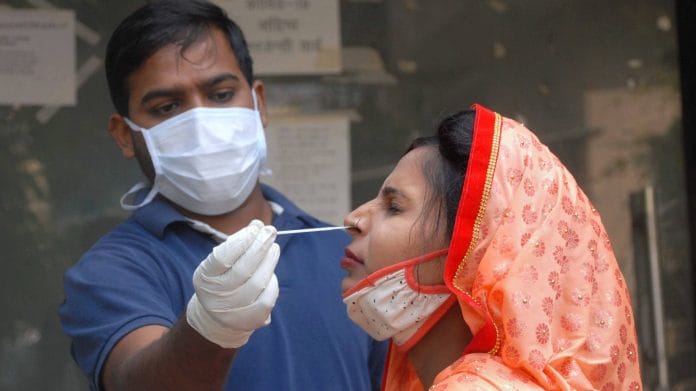New Delhi: Over a quarter of the daily Covid deaths in Delhi are happening within the first 72 hours of admission, data available with the Union Ministry of Health and Family Welfare shows.
Officials in the ministry say this is an improvement since June-July, when around 60 per cent of coronavirus deaths in the national capital were taking place within the first three days of hospital admission.
“We have learnt a lot in these last few months, about the disease and also about the need to minimise delays, yet about 26-27 per cent of patients in Delhi are still dying within the first 72 hours of coming to hospital,” a senior health ministry official told ThePrint.
“In June-July, this was about 60 per cent — about half of these deaths were happening in the first 24 hours then. The delay after reaching the hospital used to be enormous then, sometimes up to six hours. Now, that has been brought down to 45 minutes,” the official said.
Over the past 24 hours, the national capital saw 99 deaths, taking its total Covid fatalities to 7,713. The city’s case fatality rate (CFR, which is the percentage of Covid patients dying) currently stands at 1.58 per cent — higher than the national average of 1.47.
Grappling with what is being described as the third Covid wave, the Delhi government is seeking to bring back some restrictions with respect to events or places marked by large gatherings.
The Aam Aadmi Party administration has approached the central government to seek powers to impose lockdowns in big markets that may emerge as hosts of superspreader events, and has also decided to rescind its 31 October order allowing up to 200 guests at weddings, restoring the limit of 50 attendees.
Also read: Delhi govt plans to withdraw earlier order, allow only 50 people at weddings, says Kejriwal
16 contacts traced for every Delhi patient
Speaking at the health ministry briefing Tuesday, Niti Aayog member (health) Dr V.K. Paul said 16 contacts are being traced for every Covid patient in Delhi, but added that there is a need for these contacts to either observe quarantine or get themselves tested.
“We cannot take things for granted. The situation in Delhi was turning dangerous. That is why we took a slew of decisions including ramping up oxygen (supply) and ICU beds, doubling testing to 1-1.2 lakh per day,” he added. “We will put in place 10 mobile testing laboratories, of which five will start operating in the next few days. The kinds of numbers that have been projected for Delhi are unsustainable. We cannot let that happen,” he said.
A report by the National Centre for Disease Control had predicted last month that Delhi could witness upto 15,000 cases per day in the coming days.
According to Dr Paul, there are plans to raise the number of ICU beds at Delhi hospitals by 80 per cent — to 6,000 from 3,500. In coordination with the Delhi government, he added, the capacity to monitor patients in home isolation has also been increased to 40,000.
Health Secretary Rajesh Bhushan said testing is now imperative for every person who develops Covid-like symptoms.
“It is now a part of Covid-appropriate behaviour to get yourself tested whenever you have symptoms. We are doubling capacity, there is test on demand, there is no reason not to test,” he added.
“The doubling of testing will happen in such a way that the balance of RT-PCR and antigen tests is right and testing does not become lopsided in favour of rapid antigen tests,” he said.
Effects of elections, festivals yet to show
The government announced Tuesday that Delhi, Kerala and West Bengal have now entered the list of top five states in terms of active cases. Close to 19 per cent of the active cases in India are currently in Maharashtra, followed by about 16 per cent in Kerala, 9 per cent in Delhi, and around 6 per cent in West Bengal and Karnataka.
However, it added that the effects of recent festivals — including Durga Puja and Diwali — and elections and bypolls across several states since October are yet to fully play out. New cases at the national level have been going down over the last few weeks, with the number falling below 30,000 in the last 24 hours.
“We believe that the effects of elections, Durga Puja, Diwali etc are still to be played out in full. We have to keep watching the new cases very carefully,” Bhushan said.
“The effects will show in the next two weeks, that is why it is very important for people to remain disciplined and to understand that the infection is not over. Large parts of the population are still vulnerable.”
There were reports of violations of Covid norms during the October-November assembly elections in Bihar, forcing the Election Commission of India to issue an advisory to political parties. But the numbers in the state continue to be low even as the state prepares for its biggest festival — Chhath — starting Thursday.
The state currently has 5,221 active coronavirus cases with 1,189 deaths as of Tuesday.
Also read: As daily Covid cases fall below 30,000, positivity rate dips to 5-month low at 3.4%







If they want to prevent COVID deaths, they should learn from the Vietnamese. They have hardly any deaths of Covid patients. A Vietnamese told me the trick is to use natural ventilation in the patient’s room bringing in plenty of fresh air. It also protects the health care workers. The coronavirus is airborne and WHO has given shoody guidance ignoring the airborne transmission.